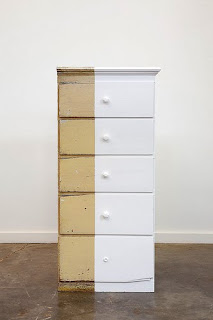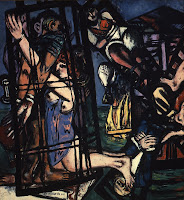I never thought much of artist Roy McMakin. But that was my own fault. A lack of investigating what he was about. Allowing this one poor monograph my store had for eons determine his whole artistic identity for me.
But the other day, I ordered and had a good look at
When a Chair is Not a Chair. I was caught by furniture and designs which were fragmented. Where he actually introduced fragments of other colors and shapes into these beautifully made pieces.
And then I found his
Eight Photographs of an Angel Wing Begonia series (of which I cannot find reproduced anywhere except the book).
Here is another version, done much simpler. They are around 30"+ in size and comprised of neatly layered photographs of the Begonias. The single clay pot they're planted in are in one piece, while the plant itself becomes fragmented and twisted.
The
closest thing I could find in his (apparently) extensive photography work was the images here. Sometimes they're photographs of his furniture. And sometimes they are photographs of other objects, drawings, etc. It's become so interesting to me to figure out how this artist takes apart his own work. And how maybe by playing with these objects in a cubist sort of fashion, the photographs have since informed his work. Just like the craftsmanship of his furniture making has informed his photography.
As I write this, I do not have anything rather important to say about McMakin that hasn't already been said. And I really haven't even done more than drool, at dozens of separate special moments, with those images in the book. At first I wanted to make all these comparisons to Cubism (check),
David Hockney's photo collages and my own work.
But after a vain search for those images, I realized it was simpler: I was responding to those photographs of the begonias, with a distorted literal and figurative language because it drew attention to how something is made. Like good paintings and how they are about painting. The comparisons then are more like
Maureen Gallace or
Les Rogers (two new favorites that come to mind). Where-in a figurative subject is only the vehicle for getting you to look at how it is made.
 |
| Cape Cod, Early September 2008 Maureen Gallace (via Whitney) |


























